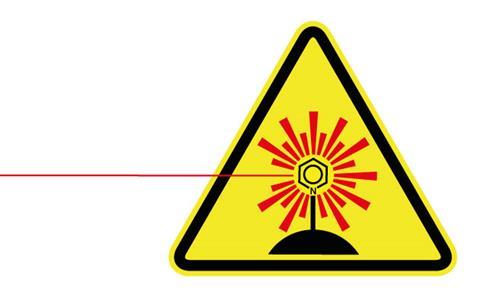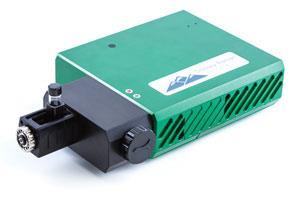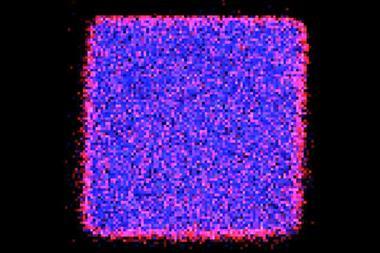Dermot Martin looks at how Sers was invented and how it is expanding its sphere of influence

It might not generate the same headlines as stunning images from Pluto or the latest discovery from the Large Hadron Collider, but laser Raman spectroscopy does occasionally appear as a blip on the news agenda. Last summer it attracted media attention in the case of Reuben Hill, a cancer patient in the UK who had brain cancer cells identified by the method and removed during surgery – when he was fully conscious and even able to sing during the operation.
We should remember that the discovery of surface-enhanced Raman spectroscopy (Sers) was a historic breakthrough which has been helping save lives in the field of healthcare and finding use in applications such as medical diagnostics, food safety, national security, environmental monitoring, fine art preservation, financial security and rapid screening. It deserves more recognition.
Away from the public gaze, Sers gives chemists a priceless insight into the nature of atoms and how they interact. But how did this technique come about? Jim McQuillan made the first Sers readings on a Corey 82 infrared spectrometer at Southampton University, UK, in the summer of 1973.
Before McQuillan’s work, if a molecule attached to a surface substrate was hit by a laser beam, the Raman response was in general too weak to be of use for analytical purposes. Working with Martin Fleischmann (of later cold fusion ‘fame’) and Pat Hendra, he found that if the surface was roughed up, the output of the Raman signal was massively enhanced. This potentially opened up a direct and instantaneous route to identifying single molecules.
Rough road
After more than four decades of research and more than 12,000 publications on the topic, there is still no complete agreement on what the precise mechanism is for Sers.
US-based scientists Richard Van Duyne at Northwestern University in Evanston, Illinois, and Martin Moskovits at the University of California, Santa Barbara, have spent their careers developing different techniques for Sers looking for new applications and building teams of researchers to seek answers to the mechanism of the phenomenon.
It was Van Duyne who first used the term Sers. His Sers journey began in the early 1970s when working on the problem of the low signal output from Raman interactions with pyridine. He tried several approaches with argon laser light, but even with what was then state of the art equipment he could not capture a decent output signal.
‘The experiment seemed barely possible and of limited practical value,’ he recalls. In April 1974, he was working on obtaining the resonance Raman spectra of molecules adsorbed on the surface of electrodes. ‘Resonance Raman spectroscopy was known to have typical enhancement factors of 103–104 and I estimated that this would be enough to observe a signal with reasonable signal-to-noise ratio for one monolayer of resonant adsorbate on a single-crystal surface.’
It was soon after this that news of the experiments in Southampton reached him. ‘I opened Chemical Physics Letters and there was this eye-popping report by Fleischmann and his colleagues in Southampton describing their observation of normal Raman signals from a monolayer of pyridine adsorbed on a “roughened” silver electrode immersed in a simple aqueous electrolyte solution in an electrochemical cell,’ he explains. ‘I was stunned! They had observed count rates of about 500–1000 per second using 100mW of 514.5nm argon ion laser light.’
The Southampton group had also proved that the Raman signals were originating either from molecules directly adsorbed to the surface or very near the surface because they reversibly shifted in wavenumber and intensity with the applied electrode potential.
Silver lining
Van Duyne was scheduled to present a paper at a gathering of the International Society of Electrochemistry that September in Brighton, along the UK’s south coast from Southampton. After the meeting, he asked to visit Fleischmann’s laboratory. ‘I was graciously received by Fleischmann, who introduced me to Jim McQuillan for details on the Raman experiments,’ Van Duyne says. ‘I was keen to understand how it was possible to observe surface Raman signals from pyridine because I had calculated how unlikely this experiment was to succeed. Jim himself thought surface roughness was likely to be the key factor.’

Fleischmann had already studied electro-crystallisation phenomena in great detail, Van Duyne explains. ‘He knew that electrode surfaces such as that of silver became very rough after successive cycles of electrochemical oxidation in chloride- (or other halide-) containing aqueous solutions to form silver chloride crystallites that were reformed as silver metal islands upon reduction.’
It wasn’t just Fleischmann who had the right expertise to enable the discovery. ‘Pat Hendra at Southampton had extensive experience in observing surface Raman spectra from pyridine adsorbed on high-surface-area Al2O3 or SiO2 powders,’ Van Duyne says. ‘It seemed clear that the surface area had been increased by several orders of magnitude so that far more pyridine molecules were being illuminated than on a flat smooth surface.’
In spite of the clarity that the surface was having an effect, the details proved elusive. ‘I was later able to show that the increased signal output was not proportionate to the increase in surface area and this triggered a fierce debate centred on the mechanism. Was it all down to surface area effect as Fleischmann accepted, or was there some other, as yet hidden, explanation?’ Van Duyne and colleague David Jeanmaire soon became convinced there was another explanation.
They carried out their own series of experiments to measure the surface enhancement factor that compared the signal intensity per molecule on the surface to the signal intensity per molecule for the same molecule in free solution and discovered a 105–106 enhancement factor associated with Sers. This result could not be explained by a surface area hypothesis.
What’s the theory?
These two ideas, the electromagnetic and chemical enhancement mechanisms, have always rubbed against each other in mechanistic debate. It still causes friction today whenever it is discussed. But there is now general acceptance that Sers relies on an electrostatic plasmonic effect in nanoparticles of certain metals.
Moskovits is a wholehearted supporter of plasmonic theory to explain the Sers effect. He argues that the alternative mechanisms proposed in the 1970s, chemical enhancement, has impeded the establishment of a universally accepted understanding, and hindered the development of Sers.
‘Today we accept that Sers theory is a classical theory based largely on electrostatics,’ says Moskovits. ‘To obtain a more complete understanding of Sers, a theory based on quantum mechanics, and approached as a dynamical theory, needs developing. Meanwhile, practical researchers should deal with the surface chemistry that arises in a given experiment on a molecule-by-molecule basis.’
Nanotechnology has reduced many of the complex variables related to Sers
In most cases, only about one in a million photons in any situation undergoes ‘simple’ Raman scattering so the sample needs to be very concentrated or subject to a long scan time to obtain a meaningful spectra.
In the case of the original Southampton experiments, at the uneven surface of the electrode the laser light becomes ‘trapped’. Because it is trapped, the electrons at the very edge of the surface become excited and form what is defined as a surface plasmon.
The intensity of Raman scattered radiation is proportional to the square of the magnitude of any electric fields acting on the analyte. The presence of the ‘roughness’ feature provides the conditions for a secondary electric field – that of the metal particle itself, which is very close to the analyte adsorbed onto the rough feature. Because of its proximity, any electric field from the particle will make a large contribution to the overall field. Under normal Raman scattering, the strength of the electromagnetic field suffers from the fact that the laser source is relatively far away, but the roughed-up surface enhances the electric field which delivers a boost to the intensity of the output signal.
This plasmon or secondary electric field is the key to Sers for practical use in many areas of chemical analysis. Materials scientists have focused for years on developing the most efficient surfaces to exploit this beneficial plasmon effect. Ingenious techniques to create substrates now exist with the major goal to design discrete handheld Raman devices to detect concentrations down to single molecules for use in a vast range of applications from medical diagnostics and food safety to environmental monitoring and security.
Nano revolution
Because Sers is a nanoscale phenomenon rapid advances in nanotechnology have accelerated research over the last decade. ‘Nanotechnology has given us the ability to control the shape and orientation of nanoparticles on a surface,’ says Van Duyne. ‘It has reduced many of the complex variables related to Sers and has greatly enhanced our understanding.’

Major improvements in Raman instrumentation and in solid-state lasers have dramatically reduced costs, making Raman almost as ubiquitous an analysis technology as infrared spectroscopy.
The availability of near-field microscopes and scanning tunnelling microscopy and spectroscopy has led to the creation of an entire industry dedicated to making small, cheap Raman devices. Van Duyne is proud that companies such as Snowy Range, which was founded in Wyoming by Keith Carron, one of Van Duyne’s former PhD students, are thriving in this sector.
Both Moskovits and Van Duyne believe that Sers’ best days still lie ahead, but difficult issues remain to overcome. There are many molecules of interest that do not adsorb spontaneously on silver and gold surfaces.
Gold and silver have always been at the heart of Sers because they have a full d orbital of electrons and a single s electron. This shielded or ‘free’ electron is the driving force behind the creation of surface localised electric fields.
That does not mean there are no other options so Moskovits and Van Duyne and most others in the field believe it is essential to design new substrates and molecular capture strategies using nanotechnology. Research and trials have been carried out on partition layers similar to HPLC supports, transition metal overlayers, covalent capture ligands, metal organic frameworks and aptamers.
Sensing the future
Last summer, Shekhar Sharma and a team at the Agri Food and Biosciences Institute in Belfast, Northern Ireland, announced the results of tests on a new substrate based on nanostructures and using copper. They used measured volumes of the model dye rhodamine 6G dried onto a substrate consisting of a copper surface on which metallic silver in the form of nanostructures and dendritic accumulations had been deposited. His results showed that Sers was able to detect the dye down to a concentration of 0.5µM (0.240ppm) which, according to Sharma, would match the detection levels of a laboratory LCMS system. The difference is of course that LCMS systems cost upwards of £500,000, whereas a handheld Raman device would cost around somewhere between £20,000 and £50,000 – still expensive, but a lot less stressful on the budget.
If we can tune a substrate to any excitation wavelength, the game will change
This new substrate was tested for its ability to detect both melamine, a potential food contaminant, and glyphosate, an organophosphate herbicide. The group detected melamine down to a level of 0.126ppm, and glyphosate at 0.845ppm. The Sers technique enhancement factor was determined and averaged at about 105 over conventional Raman spectroscopy. Two companies have already expressed interest in this AFBI substrate and further research has been picked up by a group at Queen’s University, Belfast.
At the heart of Sers substrate research is a universal substrate with a possible use over a broad range of excitation wavelengths. ‘If we can learn to tune a substrate to any excitation wavelength from say ~320nm – which is the cut-off point for silver – to 1200nm, the game will change,’ says Van Duyne. It might be possible using chip technology in which the chip has either a gradient of spheres or sub-chips with an array of sphere sizes to achieve some kind of universality.
Trying to reach this goal, Nan Zhang, Qiaoqiang Gan and colleagues at the University of Buffalo in the US and Fudan University in China created a substrate with a ‘broadband’ nanostructure which traps light between 450 and 1100nm. ‘We’ve really progressed on how to enhance the localised electric field and further improve the Sers performance,’ Zhang explains. ‘Currently, we can realise a higher enhancement factor to resolve smaller amounts of chemical/biomolecules. This is excellent for sensing trace molecules in security and defense.’
The team is now trying to extend the work. ‘We are on the track of a low-cost but ultra-broadband super-absorbing metasurface substrate. It can localise electromagnetic fields at the edges of surface nanopatterns and generate hot spots over a wide-range of excitation wavelengths. This unique feature has been validated using Sers sensing experiments which are sensitive to the localised field intensity applications.’
Moskovits is upbeat about the potential for Sers. ‘Sers applications are likely to be in chemical analysis, making use of the inordinate sensitivity of Sers which under favorable circumstances can detect a single molecule, or in bio-sensing and bio-imaging, such as using Sers as a probe that can simultaneously report the presence of multiple biomarkers on a single cell – something fluorescence cannot do reliably.’
The design of substrates to enhance signals to enormous levels and the development of so-called tip-enhanced Raman spectroscopy, with its potential ability to define a single molecule, makes for exciting days ahead.
Space probes and particle accelerators will no doubt continue to attract rave reviews and make headline news round the world. Meanwhile humble chemists, delving into the mysteries of inner space, continue quietly on their Sers odyssey to a deeper understanding of the molecular world. But if they do succeed in designing a universal Sers substrate, for example, don’t expect to see it on the six o’clock news.
Dermot Martin is a science writer based in Dorset, UK
Editor’s note: We published a letter highlighting Alan Creighton’s role in the development of Sers in the February 2016 issue.












No comments yet